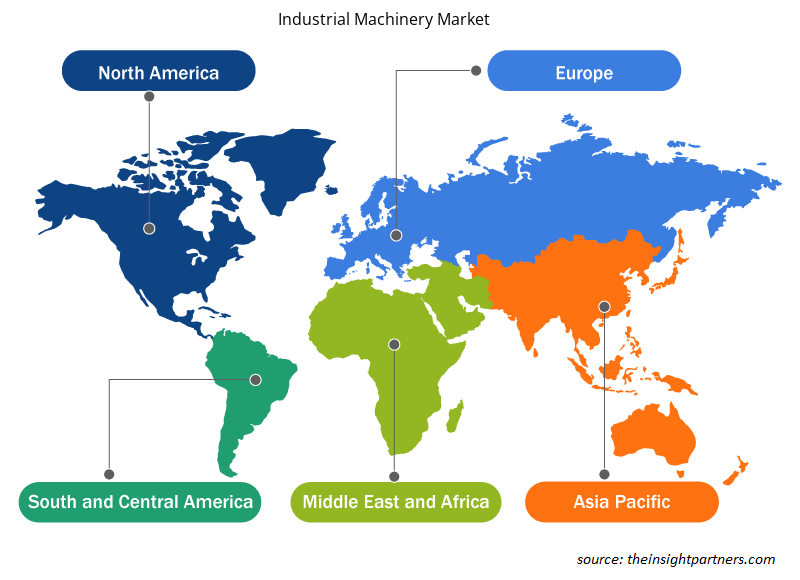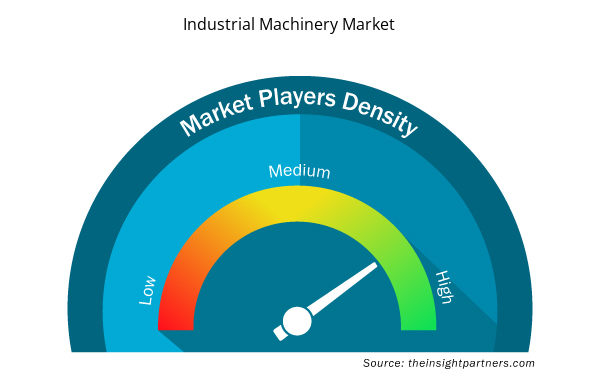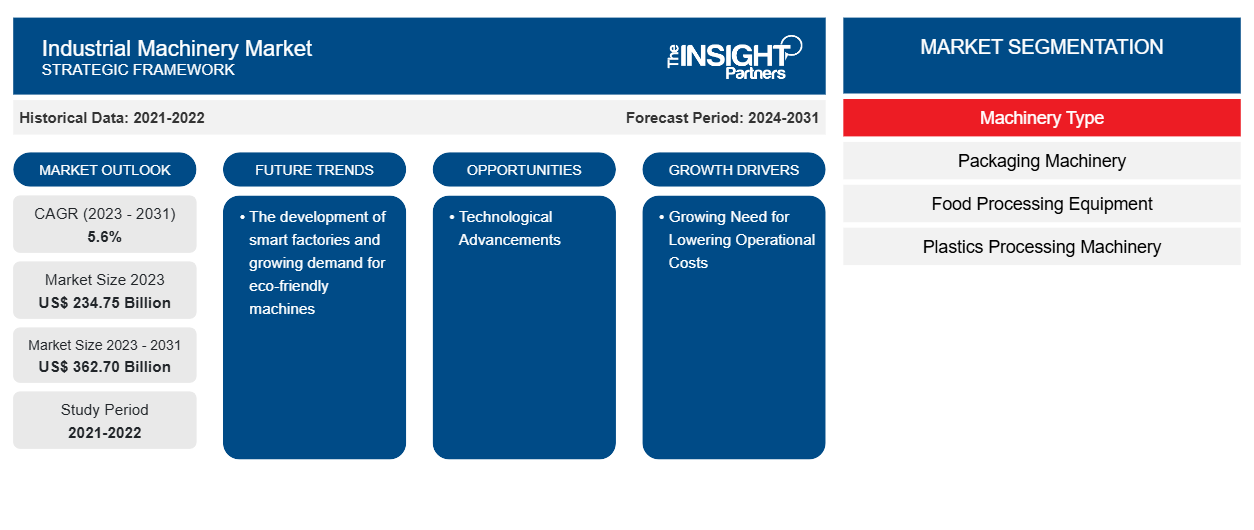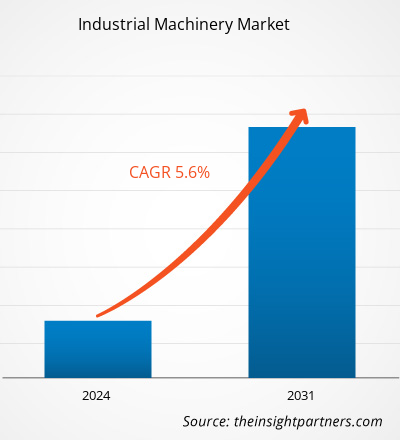Der Markt für Industriemaschinen soll von 234,75 Milliarden US-Dollar im Jahr 2023 auf 362,70 Milliarden US-Dollar im Jahr 2031 anwachsen. Der Markt soll zwischen 2023 und 2031 eine durchschnittliche jährliche Wachstumsrate (CAGR) von 5,6 % verzeichnen. Die Entwicklung intelligenter Fabriken und die wachsende Nachfrage nach umweltfreundlichen Maschinen dürften weiterhin ein wichtiger Trend auf dem Markt für Industriemaschinen bleiben.
Marktanalyse für Industriemaschinen
Der Markt für Industriemaschinen wächst rasant, da die Notwendigkeit zur Senkung der Betriebskosten zunimmt und Industriemaschinen zunehmend in der Automobil-, Lebensmittel- und Getränkeindustrie, der Pharmaindustrie, der Fertigungsindustrie und anderen Branchen eingesetzt werden. Der Markt wächst stetig, angetrieben durch die zunehmende Urbanisierung und industrielle Automatisierung . Darüber hinaus bieten technologische Fortschritte und die Integration von KI und 3D-Digitaldrucktechnologie lukrative Möglichkeiten für Marktwachstum.
Marktübersicht für Industriemaschinen
Unter Industriemaschinen versteht man alle mechanischen, elektrischen oder elektronischen Geräte, die dazu bestimmt sind, eine bestimmte Funktion auszuführen und ein bestimmtes Ergebnis zu erzielen. Hersteller in Fertigungsanlagen verwenden diese Maschinen zum Schneiden, Formen, Laminieren oder Koordinieren von Produktionsprozessen. Industriemaschinen spielen eine entscheidende Rolle bei der Unterstützung industrieller Aktivitäten weltweit. Die zunehmende Digitalisierung, technologische Fortschritte und Industrie 4.0-Initiativen schaffen Chancen auf dem Markt.
Passen Sie diesen Bericht Ihren Anforderungen an
Sie erhalten kostenlos individuelle Anpassungen an jedem Bericht, einschließlich Teilen dieses Berichts oder einer Analyse auf Länderebene, eines Excel-Datenpakets sowie tolle Angebote und Rabatte für Start-ups und Universitäten.
- Holen Sie sich die wichtigsten Markttrends aus diesem Bericht.Dieses KOSTENLOSE Beispiel umfasst eine Datenanalyse von Markttrends bis hin zu Schätzungen und Prognosen.
Treiber und Chancen auf dem Industriemaschinenmarkt
Wachsender Bedarf zur Senkung der Betriebskosten treibt den Markt an
Niedrigere Betriebskosten führen zu höheren Margen, sodass Unternehmen ihr Produktangebot diversifizieren und durch Kostensenkungsmaßnahmen neue Märkte erschließen können. Der wachsende Bedarf der Unternehmen an niedrigeren Betriebskosten erhöht die Nachfrage nach technologisch fortschrittlichen Maschinen. Hersteller integrieren IoT-Anwendungen in diese Geräte, um erweiterte Dienste wie Fernüberwachung, zentrale Feedbacksysteme und andere Funktionen bereitzustellen. Darüber hinaus setzen Hersteller auch verbesserte Sensoren, mobile Apps und eingebettete Software ein, um ihre Betriebsabläufe zu optimieren, indem sie die Gesamtbetriebskosten senken, was den Markt antreibt.IoT applications into these devices to provide enhanced services such as remote monitoring, central feedback systems, and other features. Moreover, manufacturers are also adopting enhanced sensors, mobile apps, and embedded software to streamline their operational processes by lowering the overall business costs is driving the market.
Technologischer Fortschritt – eine Chance auf dem Markt für Industriemaschinen
Es wird erwartet, dass schnelle technologische Fortschritte im Prognosezeitraum die Innovation auf dem Markt für Industriemaschinen vorantreiben werden. Darüber hinaus setzen Fertigungsindustrien fortschrittliche Technologien wie künstliche Intelligenz, 3D-Druck und Big-Data-Analyse ein, um Betriebskosten zu senken, die Produktivität zu verbessern und höhere Gewinne zu erzielen. Die potenzielle Integration von 3D-Druck und KI-Technologie schafft jedoch Wachstumschancen für internationale und inländische Akteure auf dem Markt für Industriemaschinen.
Segmentierungsanalyse des Marktberichts für Industriemaschinen
Wichtige Segmente, die zur Ableitung der Marktanalyse für Industriemaschinen beigetragen haben, sind die Maschinentypen.
- Basierend auf dem Maschinentyp ist der Markt für Industriemaschinen in Verpackungsmaschinen, Lebensmittelverarbeitungsgeräte, Maschinen zur Kunststoffverarbeitung, Werkzeugmaschinen zur Metallumformung und Holzbearbeitungsmaschinen unterteilt.
- Das Segment Verpackungsmaschinen ist in Abfüllmaschinen, Palettiermaschinen, Etikettiermaschinen, Verpackungsmaschinen und andere unterteilt. Das Segment Lebensmittelverarbeitungsgeräte ist in Schneide- und Würfelschneidemaschinen, Extruder, Dosier- und Mischmaschinen, Lager- und Kühlgeräte und andere unterteilt. Das Segment Kunststoffverarbeitungsmaschinen ist in Inspektionsformmaschinen, Blasformmaschinen, Extrusionsformmaschinen und andere unterteilt. Das Segment Metallformmaschinen ist in Druckmaschinen, Biegemaschinen, Gussmaschinen, Stanzmaschinen und andere unterteilt. Das Segment Holzbearbeitungsmaschinen ist in Drehmaschinen, Schleifmaschinen, Bandsägemaschinen und andere unterteilt.
Marktanteilsanalyse für Industriemaschinen nach Geografie
Der geografische Umfang des Marktberichts für Industriemaschinen ist hauptsächlich in fünf Regionen unterteilt: Nordamerika, Asien-Pazifik, Europa, Naher Osten und Afrika sowie Südamerika/Süd- und Mittelamerika.
Gemessen am Umsatz hatte der asiatisch-pazifische Raum den größten Marktanteil im Bereich Industriemaschinen, was auf die steigenden Investitionen in Infrastrukturprojekte wie Transport, Energie und Stadtentwicklung zurückzuführen ist. Der wachsende Bedarf an einer Vielzahl von Industriegeräten wie Baumaschinen, Erdbewegungsmaschinen und Materialtransportgeräten treibt den Markt in der Region an.earthmoving equipment, and material handling equipment, is fueling the market in the region.
Regionale Einblicke in den Markt für Industriemaschinen
Die regionalen Trends und Faktoren, die den Markt für Industriemaschinen im Prognosezeitraum beeinflussen, wurden von den Analysten von Insight Partners ausführlich erläutert. In diesem Abschnitt werden auch Marktsegmente und Geografien für Industriemaschinen in Nordamerika, Europa, im asiatisch-pazifischen Raum, im Nahen Osten und Afrika sowie in Süd- und Mittelamerika erörtert.

- Erhalten Sie regionale Daten zum Industriemaschinenmarkt
Umfang des Marktberichts für Industriemaschinen
| Berichtsattribut | Details |
|---|---|
| Marktgröße im Jahr 2023 | 234,75 Milliarden US-Dollar |
| Marktgröße bis 2031 | 362,70 Milliarden US-Dollar |
| Globale CAGR (2023 - 2031) | 5,6 % |
| Historische Daten | 2021-2022 |
| Prognosezeitraum | 2024–2031 |
| Abgedeckte Segmente | Nach Maschinentyp
|
| Abgedeckte Regionen und Länder | Nordamerika
|
| Marktführer und wichtige Unternehmensprofile |
|
Marktteilnehmerdichte für Industriemaschinen: Auswirkungen auf die Geschäftsdynamik verstehen
Der Markt für Industriemaschinen wächst rasant, angetrieben durch die steigende Nachfrage der Endverbraucher aufgrund von Faktoren wie sich entwickelnden Verbraucherpräferenzen, technologischen Fortschritten und einem größeren Bewusstsein für die Vorteile des Produkts. Mit steigender Nachfrage erweitern Unternehmen ihr Angebot, entwickeln Innovationen, um die Bedürfnisse der Verbraucher zu erfüllen, und nutzen neue Trends, was das Marktwachstum weiter ankurbelt.
Die Marktteilnehmerdichte bezieht sich auf die Verteilung der Firmen oder Unternehmen, die in einem bestimmten Markt oder einer bestimmten Branche tätig sind. Sie gibt an, wie viele Wettbewerber (Marktteilnehmer) in einem bestimmten Marktraum im Verhältnis zu seiner Größe oder seinem gesamten Marktwert präsent sind.
Die wichtigsten auf dem Markt für Industriemaschinen tätigen Unternehmen sind:
- AB Electrolux
- Alfa Laval
- AMADA CO., LTD.
- GEA Group
- HAITIAN INTERNATIONAL
- MITSUBISHI HEAVY INDUSTRIES, LTD
Haftungsausschluss : Die oben aufgeführten Unternehmen sind nicht in einer bestimmten Reihenfolge aufgeführt.

- Überblick über die wichtigsten Akteure auf dem Markt für Industriemaschinen
Neuigkeiten und aktuelle Entwicklungen zum Industriemaschinenmarkt
Der Markt für Industriemaschinen wird durch die Erhebung qualitativer und quantitativer Daten nach Primär- und Sekundärforschung bewertet, die wichtige Unternehmensveröffentlichungen, Verbandsdaten und Datenbanken umfasst. Im Folgenden finden Sie eine Liste der Entwicklungen auf dem Markt für Industriemaschinen und Strategien:
- Im November 2022 brachte Ingersoll Rand den 135MAX Heavy Duty Air Hammer für den industriellen Einsatz auf den Markt. Der 135MAX HD Air Hammer ist der Drucklufthammer der nächsten Generation, der auf der Grundlage des 119MAX aufbaut und unglaubliche Leistung und Kraft zu einem erschwinglichen Preis bietet – und gleichzeitig einen fein abgestimmten, federnden Auslöser nutzt, der von den legendären Ingersoll Rand-Schlagschraubern inspiriert ist, für mehr Präzision und noch bessere Ergebnisse. (Quelle: Ingersoll Rand, Pressemitteilung, 2022)
Marktbericht zum Industriemaschinenbau – Umfang und Ergebnisse
Der Bericht „Marktgröße und Prognose für Industriemaschinen (2021–2031)“ bietet eine detaillierte Analyse des Marktes, die die folgenden Bereiche abdeckt:
- Marktgröße und Prognose auf globaler, regionaler und Länderebene für alle wichtigen Marktsegmente, die im Rahmen des Projekts abgedeckt sind
- Marktdynamik wie Treiber, Beschränkungen und wichtige Chancen
- Wichtige Zukunftstrends
- Detaillierte PEST/Porters Five Forces- und SWOT-Analyse
- Globale und regionale Marktanalyse mit wichtigen Markttrends, wichtigen Akteuren, Vorschriften und aktuellen Marktentwicklungen
- Branchenlandschaft und Wettbewerbsanalyse, einschließlich Marktkonzentration, Heatmap-Analyse, prominenten Akteuren und aktuellen Entwicklungen
- Detaillierte Firmenprofile
- Historische Analyse (2 Jahre), Basisjahr, Prognose (7 Jahre) mit CAGR
- PEST- und SWOT-Analyse
- Marktgröße Wert/Volumen – Global, Regional, Land
- Branche und Wettbewerbsumfeld
- Excel-Datensatz



Report Coverage
Revenue forecast, Company Analysis, Industry landscape, Growth factors, and Trends

Segment Covered
This text is related
to segments covered.

Regional Scope
North America, Europe, Asia Pacific, Middle East & Africa, South & Central America

Country Scope
This text is related
to country scope.
Häufig gestellte Fragen
The global industrial machinery market was estimated to be US$ 234.75 billion in 2023 and is expected to grow at a CAGR of 5.6% during the forecast period 2023 - 2031.
The growing need for lowering operational costs and the increasing adoption of industrial machinery from automotive, food & beverages, pharmaceutical, manufacturing, and other industries are the major factors that propel the global industrial machinery market.
The development of smart factories and the growing demand for eco-friendly machines are anticipated to play a significant role in the global industrial machinery market in the coming years.
The key players holding majority shares in the global industrial machinery market are AB Electrolux, Alfa Laval, AMADA CO., LTD., GEA Group, and HAITIAN INTERNATIONAL.
The global industrial machinery market is expected to reach US$ 362.70 billion by 2031.
The incremental growth expected to be recorded for the global industrial machinery market during the forecast period is US$ 127.95 billion.
Trends and growth analysis reports related to Electronics and Semiconductor : READ MORE..
The Insight Partners performs research in 4 major stages: Data Collection & Secondary Research, Primary Research, Data Analysis and Data Triangulation & Final Review.
- Data Collection and Secondary Research:
As a market research and consulting firm operating from a decade, we have published and advised several client across the globe. First step for any study will start with an assessment of currently available data and insights from existing reports. Further, historical and current market information is collected from Investor Presentations, Annual Reports, SEC Filings, etc., and other information related to company’s performance and market positioning are gathered from Paid Databases (Factiva, Hoovers, and Reuters) and various other publications available in public domain.
Several associations trade associates, technical forums, institutes, societies and organization are accessed to gain technical as well as market related insights through their publications such as research papers, blogs and press releases related to the studies are referred to get cues about the market. Further, white papers, journals, magazines, and other news articles published in last 3 years are scrutinized and analyzed to understand the current market trends.
- Primary Research:
The primarily interview analysis comprise of data obtained from industry participants interview and answers to survey questions gathered by in-house primary team.
For primary research, interviews are conducted with industry experts/CEOs/Marketing Managers/VPs/Subject Matter Experts from both demand and supply side to get a 360-degree view of the market. The primary team conducts several interviews based on the complexity of the markets to understand the various market trends and dynamics which makes research more credible and precise.
A typical research interview fulfils the following functions:
- Provides first-hand information on the market size, market trends, growth trends, competitive landscape, and outlook
- Validates and strengthens in-house secondary research findings
- Develops the analysis team’s expertise and market understanding
Primary research involves email interactions and telephone interviews for each market, category, segment, and sub-segment across geographies. The participants who typically take part in such a process include, but are not limited to:
- Industry participants: VPs, business development managers, market intelligence managers and national sales managers
- Outside experts: Valuation experts, research analysts and key opinion leaders specializing in the electronics and semiconductor industry.
Below is the breakup of our primary respondents by company, designation, and region:

Once we receive the confirmation from primary research sources or primary respondents, we finalize the base year market estimation and forecast the data as per the macroeconomic and microeconomic factors assessed during data collection.
- Data Analysis:
Once data is validated through both secondary as well as primary respondents, we finalize the market estimations by hypothesis formulation and factor analysis at regional and country level.
- Macro-Economic Factor Analysis:
We analyse macroeconomic indicators such the gross domestic product (GDP), increase in the demand for goods and services across industries, technological advancement, regional economic growth, governmental policies, the influence of COVID-19, PEST analysis, and other aspects. This analysis aids in setting benchmarks for various nations/regions and approximating market splits. Additionally, the general trend of the aforementioned components aid in determining the market's development possibilities.
- Country Level Data:
Various factors that are especially aligned to the country are taken into account to determine the market size for a certain area and country, including the presence of vendors, such as headquarters and offices, the country's GDP, demand patterns, and industry growth. To comprehend the market dynamics for the nation, a number of growth variables, inhibitors, application areas, and current market trends are researched. The aforementioned elements aid in determining the country's overall market's growth potential.
- Company Profile:
The “Table of Contents” is formulated by listing and analyzing more than 25 - 30 companies operating in the market ecosystem across geographies. However, we profile only 10 companies as a standard practice in our syndicate reports. These 10 companies comprise leading, emerging, and regional players. Nonetheless, our analysis is not restricted to the 10 listed companies, we also analyze other companies present in the market to develop a holistic view and understand the prevailing trends. The “Company Profiles” section in the report covers key facts, business description, products & services, financial information, SWOT analysis, and key developments. The financial information presented is extracted from the annual reports and official documents of the publicly listed companies. Upon collecting the information for the sections of respective companies, we verify them via various primary sources and then compile the data in respective company profiles. The company level information helps us in deriving the base number as well as in forecasting the market size.
- Developing Base Number:
Aggregation of sales statistics (2020-2022) and macro-economic factor, and other secondary and primary research insights are utilized to arrive at base number and related market shares for 2022. The data gaps are identified in this step and relevant market data is analyzed, collected from paid primary interviews or databases. On finalizing the base year market size, forecasts are developed on the basis of macro-economic, industry and market growth factors and company level analysis.
- Data Triangulation and Final Review:
The market findings and base year market size calculations are validated from supply as well as demand side. Demand side validations are based on macro-economic factor analysis and benchmarks for respective regions and countries. In case of supply side validations, revenues of major companies are estimated (in case not available) based on industry benchmark, approximate number of employees, product portfolio, and primary interviews revenues are gathered. Further revenue from target product/service segment is assessed to avoid overshooting of market statistics. In case of heavy deviations between supply and demand side values, all thes steps are repeated to achieve synchronization.
We follow an iterative model, wherein we share our research findings with Subject Matter Experts (SME’s) and Key Opinion Leaders (KOLs) until consensus view of the market is not formulated – this model negates any drastic deviation in the opinions of experts. Only validated and universally acceptable research findings are quoted in our reports.
We have important check points that we use to validate our research findings – which we call – data triangulation, where we validate the information, we generate from secondary sources with primary interviews and then we re-validate with our internal data bases and Subject matter experts. This comprehensive model enables us to deliver high quality, reliable data in shortest possible time.


 Holen Sie sich ein kostenloses Muster für diesen Bericht
Holen Sie sich ein kostenloses Muster für diesen Bericht